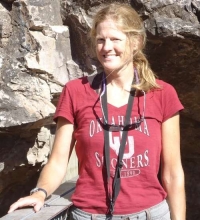Affiliation: University of Oklahoma

Bonnie Pitblado is Professor of Anthropology and the Robert and Virginia Bell Endowed Chair in Anthropology at the University of Oklahoma, and she holds her degrees from Carleton College and the University of Arizona (MA and PhD). Her research interests include the archaeology of the Paleoindian period, particularly the initial peopling of the New World more than 13,000 years ago, and the initial peopling of the Rocky Mountains. Her current publication project is Peopling of the Americas: Central Controversies of the 21st Century for the Society of American Archaeology’s “Current Perspective” book series (due out in 2019).
In the post-Covid era, the discipline of archaeology is undergoing a sea change. Rather than conducting archaeology to learn first and foremost about the past, more and more archaeologists practice archaeology as way to serve people in the present. Some archaeologists, for example, focus their attention and expertise on helping First Nations communities in Canada locate family members lost in historic boarding school violence. Others serve the Black community, as descendants seek to identify victims of the Tulsa (and other) race massacres and to provide a more nuanced understanding of all the people who lived and toiled on southern plantations. Still others, including the speaker, are creating programs to change the demographics of the student pipeline, to help diversify a discipline traditionally practiced by a homogenous majority. This talk provides enough archaeological history to provide context for understanding the shift that is occurring, then shares case studies of contemporary archaeological work being done to help redress wrongs of the past and more broadly serve people in the present.
Ancient Apocalypse, Ancient Aliens and similar programming billed to the public as “documentaries” have a history of attributing the most remarkable archaeological sites in the Western Hemisphere to aliens or mythical human ancestors. Doing this, of course, insults the legacy of the very real people who initially reached and populated the Americas, leaving behind a rich material record. It also harms the contemporary Indigenous descendants of those most ancient Americans in important and tangible ways.
This talk explores a bit of the strange history of pseudo-archaeology that emerged before and even as archaeology became a discipline in what is now the United States in the late 1800s. It also touches on the ways that a fictional strain of “archaeology” continued alongside—perniciously drawing from—real archaeology throughout the 20th century, and how it is expressed today on the History Channel and Netflix in ways that intentionally mask its illegitimate interpretations of the archaeological record.
The final and most important part of the lecture highlights the real accomplishments of the human beings who populated the Western Hemisphere more than 12,000 and maybe as many as 20,000 or more years ago. By highlighting recent archaeological finds at sites like White Sands, New Mexico, where humans left now-fossilized footprints alongside those of Ice Age camels, mammoths, and dire wolves, the talk shows that we don’t need to make up narratives about the First Americans. Their remarkable accomplishments far outshine those of aliens, submerged Atlantians, and the other fictions the entertainment industry foists upon well-meaning viewers who are hungry to understand the deep past.